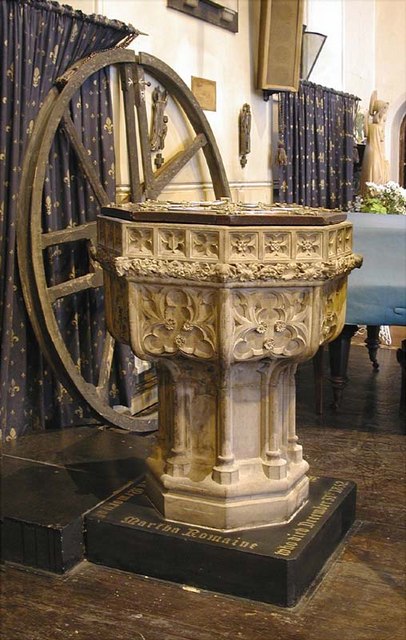|
St Mary's, Staines
St Mary's, Staines, is a Church of England parish church in the town and parish of Staines-upon-Thames, in the Borough of Spelthorne, Spelthorne borough of Surrey and the Greater London Urban Area. The parish is in the Archdeacon of Middlesex, Archdeaconry of Middlesex in the Diocese of London. The church building is on an unusual rise against the Thames River, Thames at the west end of the town. It has been a Listed building#Categories of listed building, Grade II* listed building since 11 August 1952. History History of the building The mound on which the church stands commands views over its wide spur of land between the discharge of the River Colne, Hertfordshire, Colne and the River Thames, Thames. This suggests that the first church was built on the site of an older, pre-Christian place of worship. Celtic Britons, Celtic remains have been found at Church Island south of the church, which before the navigability of the Thames was accessible in times of low flow by a ford. T ... [...More Info...] [...Related Items...] OR: [Wikipedia] [Google] [Baidu] |
Church Of England
The Church of England (C of E) is the State religion#State churches, established List of Christian denominations, Christian church in England and the Crown Dependencies. It is the mother church of the Anglicanism, Anglican Christian tradition, tradition, with foundational doctrines being contained in the ''Thirty-nine Articles'' and ''The Books of Homilies''. The Church traces its history to the Christian hierarchy recorded as existing in the Roman Britain, Roman province of Britain by the 3rd century and to the 6th-century Gregorian mission to Kingdom of Kent, Kent led by Augustine of Canterbury. Its members are called ''Anglicans''. In 1534, the Church of England renounced the authority of the Papacy under the direction of Henry VIII, beginning the English Reformation. The guiding theologian that shaped Anglican doctrine was the Reformer Thomas Cranmer, who developed the Church of England's liturgical text, the ''Book of Common Prayer''. Papal authority was Second Statute of ... [...More Info...] [...Related Items...] OR: [Wikipedia] [Google] [Baidu] |
Victoria County History
The Victoria History of the Counties of England, commonly known as the Victoria County History (VCH), is an English history project which began in 1899 with the aim of creating an encyclopaedic history of each of the historic counties of England, and was dedicated to Queen Victoria. In 2012 the project was rededicated to Queen Elizabeth II in celebration of her Diamond Jubilee year. Since 1933 the project has been coordinated by the Institute of Historical Research in the University of London. History The history of the VCH falls into three main phases, defined by different funding regimes: an early phase, 1899–1914, when the project was conceived as a commercial enterprise, and progress was rapid; a second more desultory phase, 1914–1947, when relatively little progress was made; and the third phase beginning in 1947, when, under the auspices of the Institute of Historical Research, a high academic standard was set, and progress has been slow but reasonably steady. These ... [...More Info...] [...Related Items...] OR: [Wikipedia] [Google] [Baidu] |
Laleham
Laleham is a village on the River Thames, in the borough of Spelthorne, about west of central London, England. Historically part of the county of Middlesex, it was transferred to Surrey in 1965. Laleham is downriver from Staines-upon-Thames and upriver from Chertsey. The north of the area has a number of sports fields, including the Staines and Laleham Sports Ground, and two family pubs, one each on the Laleham and Ashford Roads. Laleham Park, by the River Thames, is south of the village. Laleham is just over from three motorway junctions. The nearest railway station is , north, on the Waterloo to Reading Line. Two Surrey County Council bus routes serve the village. The poet Matthew Arnold (1822–88) lived here, dividing his time between Laleham and Rugby School. History The toponym "Laleham" comes from ''lael'' meaning twig and ''hamm'' (land in a river bend) or from Lella's ham (cognate with holm or homestead), meaning farmstead owned by a person named similarly ... [...More Info...] [...Related Items...] OR: [Wikipedia] [Google] [Baidu] |
Ashford, Surrey
Ashford is a town in Borough of Spelthorne, Spelthorne, in Surrey, England, including some areas within the London Borough of Hounslow. The town lies west of central London. Its name derives from a Ford (crossing), crossing point of the River Ash, Surrey, River Ash, a distributary of the River Colne, Hertfordshire, River Colne. Historically part of Middlesex, the town has been part of Surrey since 1965. Ashford consists of relatively low density low- and medium-rise buildings, none of them being high rise. If excluding apartments (at the last census 27% of the housing stock) most houses are semi-detached. In 2011 it had a population of 27,382. Ashford railway station (Surrey), Ashford railway station, on the Waterloo to Reading Line, is served by South Western Railway (train operating company), South Western Railway. Heathrow Airport is north of the town. A leading gymnastics club, HMP Bronzefield and one of the sites of Brooklands College are in the town. Ashford Hospital, w ... [...More Info...] [...Related Items...] OR: [Wikipedia] [Google] [Baidu] |
Westminster Abbey
Westminster Abbey, formally titled the Collegiate Church of Saint Peter at Westminster, is an Anglican church in the City of Westminster, London, England. Since 1066, it has been the location of the coronations of 40 English and British monarchs and a burial site for 18 English, Scottish, and British monarchs. At least 16 royal weddings have taken place at the abbey since 1100. Although the origins of the church are obscure, an abbey housing Benedictine monks was on the site by the mid-10th century. The church got its first large building from the 1040s, commissioned by King Edward the Confessor, who is buried inside. Construction of the present church began in 1245 on the orders of Henry III. The monastery was dissolved in 1559, and the church was made a royal peculiar – a Church of England church, accountable directly to the sovereign – by Elizabeth I. The abbey, the Palace of Westminster and St Margaret's Church became a UNESCO World Heritage Site in 1987 becaus ... [...More Info...] [...Related Items...] OR: [Wikipedia] [Google] [Baidu] |
Rectory
A clergy house is the residence, or former residence, of one or more priests or ministers of a given religion, serving as both a home and a base for the occupant's ministry. Residences of this type can have a variety of names, such as manse, parsonage, presbytery, rectory, or vicarage. Function A clergy house is typically owned and maintained by a church, as a benefit to its clergy. This practice exists in many denominations because of the tendency of clergy to be transferred from one church to another at relatively frequent intervals. Also, in smaller communities, suitable housing is not always available. In addition, such a residence can be supplied in lieu of salary, which may not be able to be provided (especially at smaller congregations). Catholic clergy houses in particular may be lived in by several priests from a parish. Clergy houses frequently serve as the administrative office of the local parish, as well as a residence. They are normally located next to, or at le ... [...More Info...] [...Related Items...] OR: [Wikipedia] [Google] [Baidu] |
World War II
World War II or the Second World War (1 September 1939 – 2 September 1945) was a World war, global conflict between two coalitions: the Allies of World War II, Allies and the Axis powers. World War II by country, Nearly all of the world's countries participated, with many nations mobilising all resources in pursuit of total war. Tanks in World War II, Tanks and Air warfare of World War II, aircraft played major roles, enabling the strategic bombing of cities and delivery of the Atomic bombings of Hiroshima and Nagasaki, first and only nuclear weapons ever used in war. World War II is the List of wars by death toll, deadliest conflict in history, causing World War II casualties, the death of 70 to 85 million people, more than half of whom were civilians. Millions died in genocides, including the Holocaust, and by massacres, starvation, and disease. After the Allied victory, Allied-occupied Germany, Germany, Allied-occupied Austria, Austria, Occupation of Japan, Japan, a ... [...More Info...] [...Related Items...] OR: [Wikipedia] [Google] [Baidu] |
Apse
In architecture, an apse (: apses; from Latin , 'arch, vault'; from Ancient Greek , , 'arch'; sometimes written apsis; : apsides) is a semicircular recess covered with a hemispherical Vault (architecture), vault or semi-dome, also known as an ''exedra''. In Byzantine architecture, Byzantine, Romanesque architecture, Romanesque, and Gothic architecture, Gothic Architecture of cathedrals and great churches, Christian church architecture, church (including cathedral and abbey) architecture, the term is applied to a semi-circular or polygonal termination of the main building at the liturgical east and west, liturgical east end (where the altar is), regardless of the shape of the roof, which may be flat, sloping, domed, or hemispherical. Smaller apses are found elsewhere, especially in shrines. Definition An apse is a semicircular recess, often covered with a hemispherical vault. Commonly, the apse of a church, cathedral or basilica is the semicircular or polygonal termination to the ... [...More Info...] [...Related Items...] OR: [Wikipedia] [Google] [Baidu] |
Battlement
A battlement, in defensive architecture, such as that of city walls or castles, comprises a parapet (a defensive low wall between chest-height and head-height), in which gaps or indentations, which are often rectangular, occur at intervals to allow for the launch of arrows or other projectiles from within the defences. These gaps are termed embrasures, also called crenels or crenelles, and a wall or building with them is described as ; alternative older terms are and . The act of adding crenels to a previously unbroken parapet is termed crenellation. The function of battlements in war is to protect the defenders by giving them part of the parapet to hide behind, from which they can quickly expose themselves to launch projectiles, then retreat behind the parapet. A defensive building might be designed and built with battlements, or a manor house might be fortified by adding battlements, where no parapet previously existed, or cutting crenellations into its existing parape ... [...More Info...] [...Related Items...] OR: [Wikipedia] [Google] [Baidu] |
Inigo Jones
Inigo Jones (15 July 1573 – 21 June 1652) was an English architect who was the first significant Architecture of England, architect in England in the early modern era and the first to employ Vitruvius, Vitruvian rules of proportion and symmetry in his buildings. As the most notable architect in England, Jones was the first person to introduce the classical architecture of Rome and the Italian Renaissance to England. He left his mark on London by his design of single buildings, such as the Queen's House which is the first building in England designed in a pure classical style, and the Banqueting House, Whitehall, as well as the layout for Covent Garden square which became a model for future developments in the West End. He made major contributions to Scenic design, stage design by his work as a theatrical designer for several dozen masques, most by royal command and many in collaboration with Ben Jonson. Early life and career Beyond that he was born in Smithfield, London, Smit ... [...More Info...] [...Related Items...] OR: [Wikipedia] [Google] [Baidu] |






